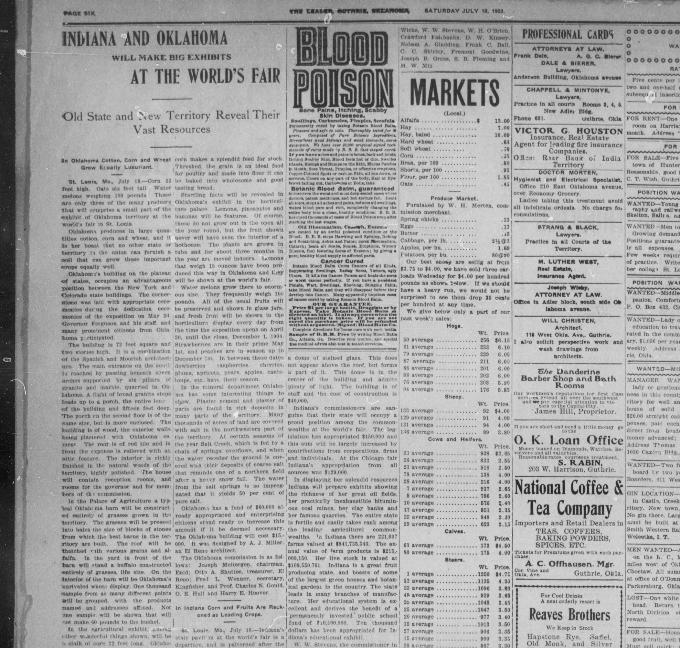|
Moderated by NW Okie! |
Volume 16 , Issue 352014Weekly eZine: (374 subscribers)Subscribe | Unsubscribe Using Desktop... |
1903 Oklahoma Prepares For 1904 's Fair

It was Saturday, 18 July 1903, The Guthrie Daily Leader, out of Guthrie, Oklahoma Territory, reported on page 6, "Indiana and Oklahoma will make big exhibits at the World's Fair." Old State and New Territory revealed their vast resources. In Oklahoma, cotton, corn and wheat grow equally luxuriant.
St. Louis, Mo., July 18 (1903) -- Corn 22 feet high. Oats six feet tall. Water melons weighing 100 pounds. These were only three of the many products that would comprise a small part of the exhibit of Oklahoma Territory at the world's fair in St. Louis.
Oklahoma produced in large quantities cotton, corn and wheat, and it was her boast that no other state or territory in the union could furnish a soil that could grow these important crops equally well.
Back in 1903, Oklahoma's building on the plateau of states, occupyied an advantageous position between the New York and Colorado state buildings. The cornerstone was laid with appropriate ceremonies during the dedication ceremonies of the exposition on May 2, 1903. Governor Ferguson and his staff, and many prominent citizens from Oklahoma participated that year.
The building was 72 feet square and two stories high. It was a combination of the Spanish and Moorish architecture. The main entrance on the south was reached by passing beneath seven arches supported by six pillars of granite and marble, quarried in Oklahoma. A flight of broad granite steps lead up to a porch, the entire length of the building and fifteen feet deep. The porch on the second floor was of the same size, but was more enclosed. The building was of wood, the exterior walls being plastered with Oklahoma cement. The roof was of red tile and in front the expense was relieved with an attic feature.The interior was richly finished in the natural woods of the territory, highly polished. The house would contain reception rooms, and rooms for the governor and for members of the commission.
In the Palace of Agriculture a typical Oklahoma barn would be constructed entirely of grasses grown in the territory. The grasses would be pressed into bales the size of blocks of stones from which the best barns in the territory were built. The roof would be thatched with various grains and alfalfa. In the yard in front of the barn would stand a buffalo constructed entirely of grasses, life size. On the interior of the barn would be Oklahoma's unrivaled wheat display. One thousand sample from as many different points would be grouped, with the products named and addresses affixed. Not one sample would be shown that would not make 60 pounds to the bushel.
In the agricultural exhibit, among other wonderful things shown, would be a stalk of corn 22 feet long. Oklahomans claim that this was the longest corn stalk even grown. Oats, too, would be shown, that were six feet long, that yield 100 bushels tot he acre.
Kaffir corn, a product of great commercial value, would be an interesting feature of the display. This peculiar grain packages of the characteristics of both wheat and corn and in a measure could take the place of either or both. It grows four and six feet tall, and in the field looks not unlike corn. The grain is in a cluster at the top where the corn tassel grows. It was round and white, a trifle larger than the ordinary grain of wheat. Kaffir corn made a splendid feed for stock. Threshed, the grain was an ideal food for poultry and made into flour it could be baked into wholesome and good tasting bread.
They were reporting that startling facts would be revealed in Oklahoma's exhibit in the horticulture palace. Lemons, pineapples and bananas would be features. Of course, these do not grow out in the open all the year round, but the fruit shown never would have seen the interior of a hothouse. The plants were grown in tubs and for about three months in the year were moved indoors. Lemons that weighed 15 ounces had been produced this way in Oklahoma and they would be shown at the world's fair.
Watermelons grow there to enormous size. They frequently with 100 pounds. All the the usual fruits would be preserved and shown in glass jars, and fresh fruit would be shown in the horticulture display every day from the time the exposition opened on April 30, until the close, December 1, 1904. Strawberries were in their prime May 1st, and peaches were in season up to December 1st. In between these dates dewberries, raspberries, cherries, plums, apricots, pears, apples, cantaloups, etc. had their season.
In the mineral department Oklahoma had some interesting things to show. Plaster cement and plaster of paris were found in rich deposits in many parts of the territory. Many thousands of acres of land were covered with salt in the northwestern part of the territory. At certain seasons of the year Salt Creek, which was fed by a chain of springs, overflowed, and when the water receded the ground was covered with thick deposits of coarse salt that reminded one of a northern field after a heavy snow fall. The water from the salt springs was so impregnated that it yielded 50 percent of the pure salt.
| View or Add Comments (1 Comments)
| Receive
updates ( subscribers) |
Unsubscribe
| © . Linda Mcgill Wagner - began © 1999 Contact Me | |
